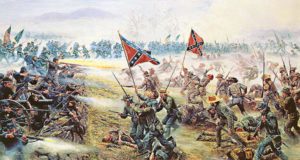 On June 24, 1863, General Robert E. Lee led his Confederate Army across the Potomac River and headed towards Pennsylvania. In response to this threat President Lincoln replaced his army commander, General Joseph Hooker, with General George Mead. As Lee’s troops poured into Pennsylvania, Mead led the Union Army north from Washington. Meade’s effort was inadvertently helped by Lee’s cavalry commander, Jeb Stuart, who, instead of reporting Union movements to Lee, had gone off on a raid deep in the Union rear. This action left Lee blind to the Union’s position. When a scout reported the Union approach, Lee ordered his scattered troops to converge west of the small village of Gettysburg, Pennsylvania.
On June 24, 1863, General Robert E. Lee led his Confederate Army across the Potomac River and headed towards Pennsylvania. In response to this threat President Lincoln replaced his army commander, General Joseph Hooker, with General George Mead. As Lee’s troops poured into Pennsylvania, Mead led the Union Army north from Washington. Meade’s effort was inadvertently helped by Lee’s cavalry commander, Jeb Stuart, who, instead of reporting Union movements to Lee, had gone off on a raid deep in the Union rear. This action left Lee blind to the Union’s position. When a scout reported the Union approach, Lee ordered his scattered troops to converge west of the small village of Gettysburg, Pennsylvania.
On July 1, some Confederate infantry headed to Gettysburg to seize much-needed shoes and clashed west of town with Union cavalry. The Union commander, recognizing the importance of holding Gettysburg because a dozen roads converged there, fought desperately to hold off the Rebel advance. Other Union troops briefly stopped some Rebels north of town. During heavy fighting, the Confederates drove the Union troops through the streets of Gettysburg to Cemetery Hill south of the town. Lee ordered General Richard Ewell, now commander of the late Stonewall Jackson’s old units, to attack this position “if practicable”, a vague order that Jackson normally took to mean launch an all-out attack. Ewell was not Jackson. He decided not to attack once he saw the Union artillery atop the hill. Had he attacked and succeeded, it might have changed the course of the war.
The rest of the armies arrived that first night. The Union army established a defensive position resembling a fish hook, with Culp’s Hill and the two Round Tops anchoring each end. Lee decided to attack both flanks the next day. On his right flank, Union troops mistakenly shifted out of position, leaving Little Round Top undefended. At the last moment, a Union general rushed troops in just ahead of the charging Confederates. After a long day of fighting, they barely held the position. The misplaced bluecoats were pushed back through The Peach Orchard, The Wheat Field, and Devil’s Den. On the left, Ewell’s assault failed due mainly to his poor leadership.
Thinking the Union center had weakened from these attacks, Lee decided the next day to hit it first with artillery, and then an infantry charge led by George Pickett’s division. Stuart’s late-arriving cavalry was to come in behind the Union center at the same time, but they were held off by Union cavalry led by a young General George Custer. After an hour’s duel, Union artillery deceived the Confederates into thinking their guns were knocked out. Then 13,000 Rebels marched across the field in front of Cemetery Hill, only to have the Union artillery open up on them, followed by deadly Federal infantry firepower. Scarcely half made it back to their own lines. In all, Lee lost more than a third of his men before retreating to Virginia. Meade, a naturally cautious man, decided the loss of one-quarter of his men had been enough, and only feebly tried to pursue Lee, missing an opportunity to crush him.